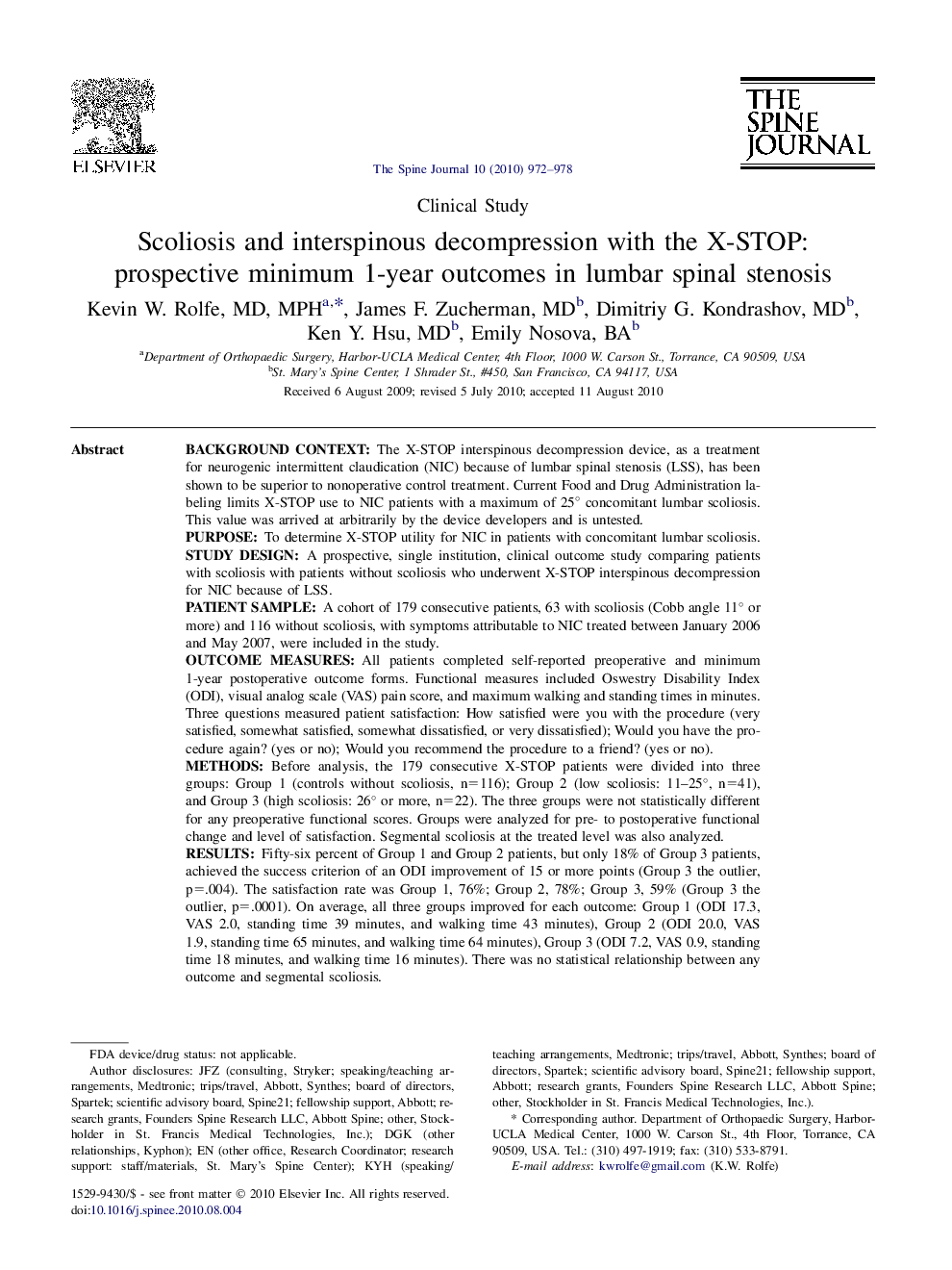| کد مقاله | کد نشریه | سال انتشار | مقاله انگلیسی | نسخه تمام متن |
|---|---|---|---|---|
| 4099461 | 1268641 | 2010 | 7 صفحه PDF | دانلود رایگان |

Background contextThe X-STOP interspinous decompression device, as a treatment for neurogenic intermittent claudication (NIC) because of lumbar spinal stenosis (LSS), has been shown to be superior to nonoperative control treatment. Current Food and Drug Administration labeling limits X-STOP use to NIC patients with a maximum of 25° concomitant lumbar scoliosis. This value was arrived at arbitrarily by the device developers and is untested.PurposeTo determine X-STOP utility for NIC in patients with concomitant lumbar scoliosis.Study designA prospective, single institution, clinical outcome study comparing patients with scoliosis with patients without scoliosis who underwent X-STOP interspinous decompression for NIC because of LSS.Patient sampleA cohort of 179 consecutive patients, 63 with scoliosis (Cobb angle 11° or more) and 116 without scoliosis, with symptoms attributable to NIC treated between January 2006 and May 2007, were included in the study.Outcome measuresAll patients completed self-reported preoperative and minimum 1-year postoperative outcome forms. Functional measures included Oswestry Disability Index (ODI), visual analog scale (VAS) pain score, and maximum walking and standing times in minutes. Three questions measured patient satisfaction: How satisfied were you with the procedure (very satisfied, somewhat satisfied, somewhat dissatisfied, or very dissatisfied); Would you have the procedure again? (yes or no); Would you recommend the procedure to a friend? (yes or no).MethodsBefore analysis, the 179 consecutive X-STOP patients were divided into three groups: Group 1 (controls without scoliosis, n=116); Group 2 (low scoliosis: 11–25°, n=41), and Group 3 (high scoliosis: 26° or more, n=22). The three groups were not statistically different for any preoperative functional scores. Groups were analyzed for pre- to postoperative functional change and level of satisfaction. Segmental scoliosis at the treated level was also analyzed.ResultsFifty-six percent of Group 1 and Group 2 patients, but only 18% of Group 3 patients, achieved the success criterion of an ODI improvement of 15 or more points (Group 3 the outlier, p=.004). The satisfaction rate was Group 1, 76%; Group 2, 78%; Group 3, 59% (Group 3 the outlier, p=.0001). On average, all three groups improved for each outcome: Group 1 (ODI 17.3, VAS 2.0, standing time 39 minutes, and walking time 43 minutes), Group 2 (ODI 20.0, VAS 1.9, standing time 65 minutes, and walking time 64 minutes), Group 3 (ODI 7.2, VAS 0.9, standing time 18 minutes, and walking time 16 minutes). There was no statistical relationship between any outcome and segmental scoliosis.ConclusionsThe outcome success rate for the X-STOP procedure to treat NIC is lower in patients with overall lumbar scoliosis more than 25° but is unaltered by segmental scoliosis at the affected level. Although patients and surgeons must be aware that the presence of more than 25° of scoliosis portends less favorable results with X-STOP implantation for NIC because of LSS, success in these patients is not precluded, and selection of treatment must be put into the context of individual patient risk and other treatment options.
Journal: The Spine Journal - Volume 10, Issue 11, November 2010, Pages 972–978